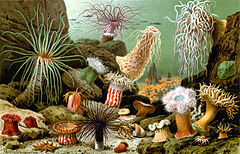Sea anemones
| Sea anemones | |
|---|---|
 |
|
| A selection of sea anemones, painted by Giacomo Merculiano, 1893 |
|
| Scientific classification | |
| Kingdom: | Animalia |
| Phylum: | Cnidaria |
| Class: | Anthozoa |
| Subclass: | Hexacorallia |
| Order: | Actiniaria |
| Suborders | |
| Diversity | |
| 46 families | |
Sea anemones are a group of water-dwelling, predatory animals of the order Actiniaria. They are named for the anemone, a terrestrial flower. Sea anemones are classified in the phylum Cnidaria, class Anthozoa, subclass Hexacorallia. Anthozoa often have large polyps that allow for digestion of larger prey and also lack a medusa stage. As cnidarians, sea anemones are related to corals, jellyfish, tube-dwelling anemones, and Hydra.
Many sea anemones form symbiotic relationships with single-celled dinoflagellates, zooxanthellae or with green algae, zoochlorellae, that live within their cells.
The global trade in marine ornamentals for aquariums is rapidly expanding, and threatens sea anemone populations as the trade depends on collection from the wild, and the animals grow and reproduce relatively slowly.
A sea anemone is a sessile polyp attached at the bottom to the surface beneath it by an adhesive foot, called a basal disc, with a column-shaped body ending in an oral disc. Most are from 1.8 to 3 cm (0.71 to 1.18 in) in diameter, but anemones as small as 4 mm (0.16 in) or as large as nearly 2 m (6.6 ft) are known. They can have from a few tens to a few hundred tentacles.
A few species are pelagic and are not attached to the bottom; instead, they have a gas chamber within the pedal disc, allowing them to float upside down in the water.
The mouth, also the anus of the sea anemone, is in the middle of the oral disc surrounded by tentacles armed with many cnidocytes, cells that are both defensive and used to capture prey. Cnidocytes contain stinging nematocysts, capsule-like organelles capable of suddenly, giving the phylum Cnidaria its name. Each nematocyst contains a small venom vesicle filled with actinotoxins, an inner filament, and an external sensory hair. A touch to the hair mechanically triggers a cell explosion, which launches a harpoon-like structure that attaches to the organism that triggered it, and injects a dose of venom in the flesh of the aggressor or prey. This gives the anemone its characteristic sticky feeling. The sea anemone eats small fish and shrimp.
...
Wikipedia
